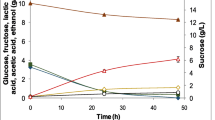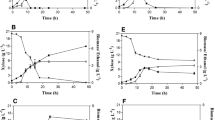Abstract
Gluconacetobacter sp. A4 (G. sp. A4), which had strong ability to produce d-saccharic acid 1, 4 lactone (DSL), was the key functional bacteria isolated from the kombucha preserved. This paper investigated the interaction between G. sp. A4 and ten different strains of lactic acid bacteria (LAB) obtained from kefir. The result suggested that the LAB promoted DSL production of G. sp. A4 to different extents, ranging from 4.86% to 86.70%. Symbiosis between G. sp. A4 and LAB was studied. LAB’s metabolites, xylitol, and acetic acid, were utilized by G. sp. A4, and it promoted the growth of G. sp. A4 and yield of DSL. Therefore, in developing starter cultures for kombucha fermentation process, a mixed flora of LAB and G. sp. A4 would be the optimal combination.






Similar content being viewed by others
References
Greenwalt, C. J., Steinkraus, K. H., & Ledford, R. A. (2000). Journal of Food Protection, 63(7), 976–981.
Liu, C. H., Hsu, S. H., & Lee, F. L. (1996). Food Microbiology, 13(6), 407–415. doi:10.1006/fmic.1996.0047.
Kurtzman, C. P., Robnett, C. J., & Basehoar-Power, E. (2001). FEMS Yeast Res, 1(2), 133–138. doi:10.1111/j.1567-1364.2001.tb00024.x.
Yoram, A. (1998) Results of Study of Magic Kombucha ® and kombuchion® in patients With HIV. Available from: persweb.direct.ca/chaugen/kombucha-research.html. Accessed February 1, 2003.
Walaszek, Z. (1990). Cancer Letters, 54(1–2), 1–8. doi:10.1016/0304-3835(90)90083-A.
Valentine, T. (1993) Kombucha, a fermented beverage with real “Zing”in it. Available from: www.kombu.de/val-gwf.htm. Accessed Jun 1, 1997.
Günther, W.F. (1996) The Kombucha Journal. Avaible from: www.kombu.de/index.htm. Accessed May 1, 2003.
Roussin, M. R. (1996) Analyses of Kombucha Ferments: Report on Growers. Available from: persweb.direct.ca/chaugen/kombucha-research-mroussin2toc.html. Accessed April 2, 2001.
Dutton, G. J. (1980), in Baca Raton: Glucuronidation of Drugs and Other Compounds, Florida, pp. 1–96.
Levvy, G. A., & Conchie, J. (1965), In Dutton G. J. (Ed.), Glucuronic acid: Free and combined: β-Glucuronidase and its hydrohysis of glucuronides. New York, pp, 301–364.
Walaszer, Z. (1993). Cancer Bulletin, 45(5), 453–457.
Hoffmann, N. (2000) The Ubiquitous Co-Enzyme UDPGlucuronic Acid Detoxifying Agent in Kombucha Tea. Available from: www.bluemarble.de/Norbert/kombucha/Glucuron/body_glucuron.htm. Accessed July 1, 2002.
Moreno, A., Matar, C., Farnworth, E., & Perdigon, G. (2006). Cytokine, 34, 1–8. doi:10.1016/j.cyto.2006.03.008.
Han, H. (2007) Study on optimization of kefir fermentation and freeze dry technics. Beijing, pp.12–13.
Judith, A. P., Mariano, L. C. and Analía, G. A. (2007) Food Hydrocolloids doi:10.1016/j.foodhyd.2007.10.005.
Ardhana, M. M., & Graham, H. F. (2003). International Journal of Food Microbiology, 86, 87–99. doi:10.1016/S0168-1605(03)00081-3.
Jayabalan, R., Marimuthu, S., & Swaminathan, K. (2007). Food Chemistry, 102(1), 392–398. doi:10.1016/j.foodchem.2006.05.032.
Chen, C., & Liu, B. Y. (2000). Journal of Applied Microbiology, 89, 834–839. doi:10.1046/j.1365-2672.2000.01188.x.
Marshall, V. M. E., & Tamine, A. Y. (1997). In B. A. Law (Ed.), Microbiology and chemistry of cheese and fermented milks: Physiology and biochemistry of fermented milk pp. 153–192. London: Blackie Academic and Professional.
Gadaga, T. H., Mtukumira, A. N., & Narvhus, J. A. (2001). International Journal of Food Microbiology, 68, 21–32. doi:10.1016/S0168-1605(01)00466-4.
Reiss, J. (1994). Lebensmittel-Untersuchung und-Forschung, 198, 258–261.
Sreeramulu, G., Zhu, Y., & Knol, W. (2000). Journal of Agricultural and Food Chemistry, 48, 2589–2594. doi:10.1021/jf991333m.
Pybus, V., & Onderdonk, A. B. (1998). FEMS Immunology and Medical Microbiology, 22, 317–327. doi:10.1111/j.1574-695X.1998.tb01221.x.
Hwang, J. W., Young, K. Y., Jae, K. H., Yu, R. P., & Yu, S. K. (1999). Journal of Bioscience and Bioengineering, 88(2), 183–188. doi:10.1016/S1389-1723(99)80199-6.
Soh, H. S., & Lee, S. P. (2002). International Journal of Food Sciences and Nutrition, 7(1), 37–42.
Tian, W. L., Ji, B. P., Li, B., & Zhang, H. (2004). Food Science China, 25(2), 161–163.
Goode, D., Lewis, M. E., & Crabbe, J. C. (1996). FEBS Letters, 395, 174–178. doi:10.1016/0014-5793(96)01012-5.
Henrik, J., Fredrik, S., & Bahram, A. (2002). BBA, 1576, 53–58.
Ishihara, M., Matsunaga, M., Hayashi, N., & Tišler, V. (2002). Enzyme and Microbial Technology, 31(7), 986–991. doi:10.1016/S0141-0229(02)00215-6.
Granström, T. B., Takata, G., Morimoto, K., Leisola, M., & Izumori, K. (2005). Enzyme and Microbial Technology, 36(7), 976–981. doi:10.1016/j.enzmictec.2005.01.027.
Matsuoka, M., Tsnchida, T., Matsushima, K., Adachi, O., & Yoshinaga, F. (1996). Bioscience, Biotechnology, and Biochemistry, 60, 575–579.
Naritomi, T., Kouda, T., Yano, H., & Yoshinaga, F. (1998). Journal of Fermentation and Bioengineering, 85(1), 89–95. doi:10.1016/S0922-338X(97)80360-1.
Author information
Authors and Affiliations
Corresponding authors
Rights and permissions
About this article
Cite this article
Yang, Z., Zhou, F., Ji, B. et al. Symbiosis between Microorganisms from Kombucha and Kefir: Potential Significance to the Enhancement of Kombucha Function. Appl Biochem Biotechnol 160, 446–455 (2010). https://doi.org/10.1007/s12010-008-8361-6
Received:
Accepted:
Published:
Issue Date:
DOI: https://doi.org/10.1007/s12010-008-8361-6




